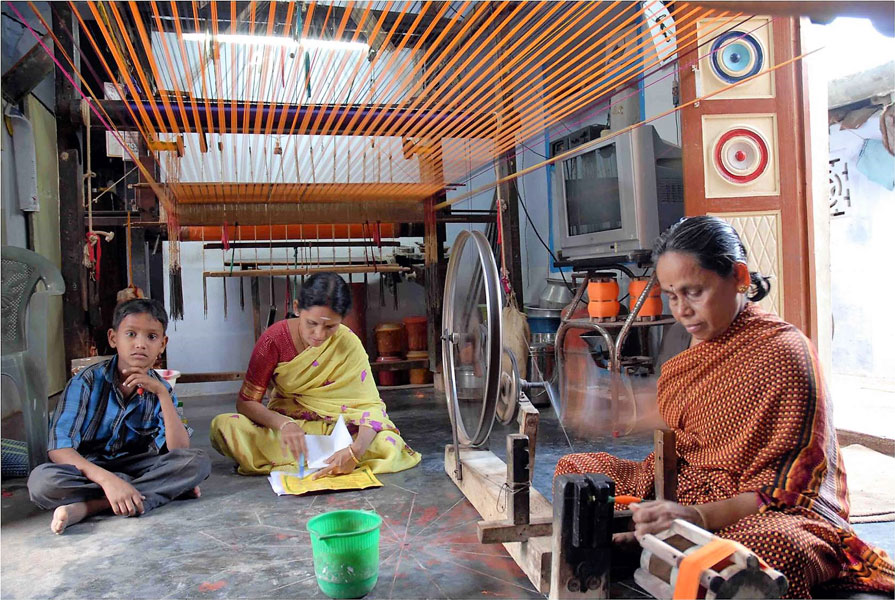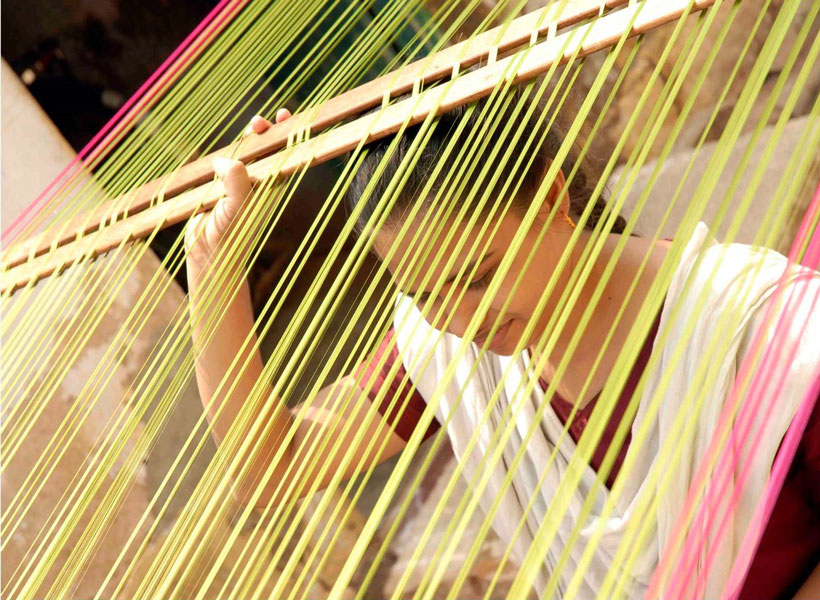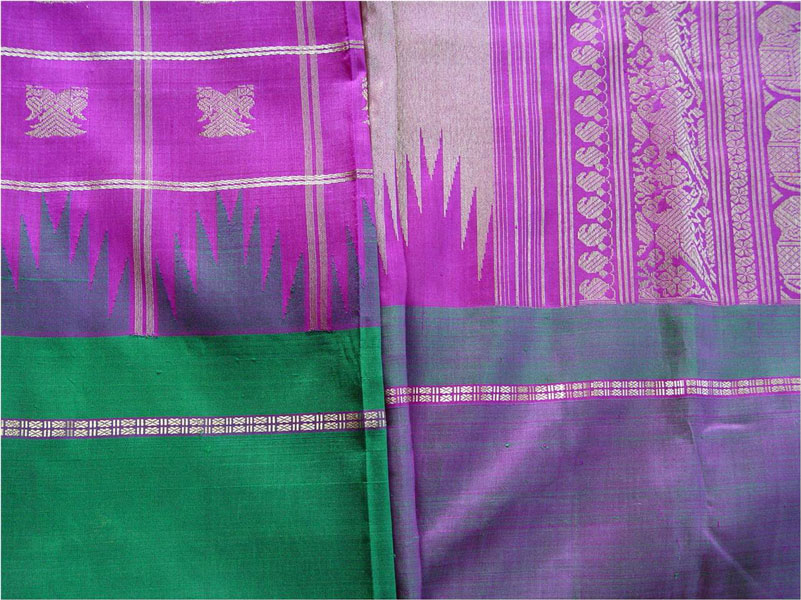A romance with India’s Textiles With this issue we begin a series of articles on the rich variety and heritage of India’s textiles.
 Recently I had the honour of taking Duke of Wellington Charles Wellesley and Duchess Antonia along a textile tour of Kancheepuram, the city of silks. It was as much a pleasure for me to explain, as it was for them to see, what a loom looked like, to distinguish warp from weft, to see a common sight in the little town, which was colourful yarn being warped on the streets, and visit the homes of the weavers, where each giant loom is the centrepiece and all life in the household revolves around it.
Recently I had the honour of taking Duke of Wellington Charles Wellesley and Duchess Antonia along a textile tour of Kancheepuram, the city of silks. It was as much a pleasure for me to explain, as it was for them to see, what a loom looked like, to distinguish warp from weft, to see a common sight in the little town, which was colourful yarn being warped on the streets, and visit the homes of the weavers, where each giant loom is the centrepiece and all life in the household revolves around it.
Suddenly it seemed to rain celebrities! I hosted the Lord Ricketts (former British Ambassador to France) and Lady Suzanne, and they loved our home, the cool breeze which wafted through, gently nudging my collection of textiles, cooling the dining room. They also enjoyed the food and watched in fascination the little kuzhi panniyarams emerging, golden brown and soft, the oothappams and the curries, and tried to learn how to make them!

They were fascinated with the slides of the textiles from different States from my powerpoint presentation. They came across as extremely warm and friendly people and theirs was a memorable visit. I tried to explain what korvai weaving meant, the expertise it involved, and how till recently the art of weaving was an oral tradition passed on from father to son.
These visits and the exercises associated with them, triggered wonderful memories of my association with Indian’s rich history of textiles.
The textile industry in India is second only to agriculture, and the history of weaving cloth in India goes back to the third millennium BC when the Indus Valley civilisation was unearthed at Mohenjodaro. What a significant discovery it was, when through excavations at Harappan sites, a scrap of coarse, madder dyed cloth was stumbled upon! The fragments of cloth were found wrapped around a silver pot, preserved by the metallic salts that impregnated the pot. The fact that the cloth was dyed with red madder indicates the knowledge of dyes in ancient India.
What a significant discovery it was, when through excavations at Harappan sites, a scrap of coarse, madder dyed cloth was stumbled upon!
Ancient Sindh deserts unearthed terracotta spindle whorls and a bronze needle. It established the fact that not only did the early inhabitants of the Indus Valley know how to spin and weave, but the coarse scrap of madder indicated that they also knew how to dye the cloth they wove. By-products of medicinal remedies from plants and minerals resulted in the delicate-toned Indian palette of colour which was vital for producing a variety of dyed indigenous cloth, sensational in their muted colour codes. These natural dyes obtained from barks of trees, leaves and nature, were the only colours known before the brilliant burst of chemical colours came to enrich the world of textiles.
The amazing diversity in textile weaving came about with every State projecting its own vocabulary of textiles. Handloom weaving and the weaver who creates the music of the loom should rightfully occupy a prestigious niche in the cultural history of India. Unfortunately, we take our heritage skills for granted and not many have pride in them.

With the passion I always had from childhhood for Indian textiles, I decided to do my bit in preserving at least an infinitesimal part of our textile culture. That was how Amrapali, my boutique was born in Madras in the early 1970s, when, apart from Varnali, which specialised in Venkatgiri saris, there was not a single shop in Madras which had a range of handlooms, handblock prints or exclusively designed textiles. Of course Government-owned shops had some of these, but they hardly stocked the kind of products the buyers could be excited about. To some extent, I filled that lacuna, and happily the journey took me to explore looms in other parts of India, studying their designs, their culture, their romance with yarn, gaining a rich knowledge of the textiles of India.
Femina and Eves Weekly were popular women’s magazines and the editors sent their reps to me without my asking, as they had heard of my boutique and the exciting designs I stored.
The challenge was introducing handlooms to a public which was oblivious of their beauty, and incorporating design and colour which made the textiles difficult to resist, through exhibitions and ramp shows, and centrespreads in leading women’s magazines. In those days Femina and Eves Weekly were popular women’s magazines and they sent their reps to me without my asking, as their editors had heard of my boutique and the exciting designs I stored. I had the honour of having Hema Malini model for the centrespread in one magazine at a time when the dream girl was at the height of her career. Those were the days when due credit was given to talent without payment!
After being 25 years in the business, I turned to voluntary work. I decided to work with weavers across the country, beginning with South India and to locate and help hapless weavers stuck in a groove, their looms empty and not being able to market their textiles. Unfortunately, modern methods of manufacturing textiles has taken its toll and most weavers prefer to join the industry with better wages and are moving out of traditional vocations. Unless we attract foreign buyers and inspire our fashion designers to use the plethora of handloom fabrics available in the country we are going to lose our heritage textiles and future generations can only gaze at them in museums.
Till today, I do not pass up a chance to show off our textiles to foreigners who visit our country. Knowing this, tourist companies send me from time to time small groups of foreign visitors who visit our home, learn about family life in Chennai, taste my cooking, learn how to make these dishes, then listen to my lectures on textiles, and admire my own textile collections.
The next article will dwell on how the textiles from different regions touched me, inspiring me to design garments with them and place them in my boutique in all their splendour with pride in their ethnicity.
Pictures by Sabita Radhakrishna

